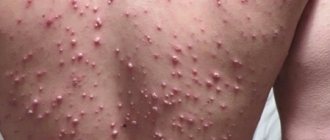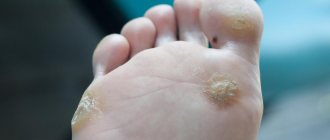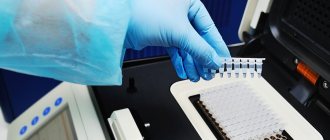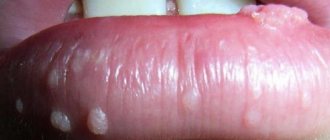When a person’s mite, Demodex folliculorum, which populates sebaceous follicles, which usually does not bother a person at all, is overly activated, and its excessive accumulation occurs, then demodicosis develops, mainly on the face and eyelids. The impetus for rapid reproduction of Demodex can be a malfunction of the immune system, hormonal levels, digestive tract functioning, allergies or infections.
The course of the disease is severe both emotionally - the aesthetic appearance of the skin of the face and eyelids suffers, and physiologically - dangerous rosacea, rhinophyma and blepharoconjunctivitis develop. Treatment of demodicosis is lengthy, requires a competent approach and daily hygiene procedures, and, alas, is not always effective.
Signs of demodicosis
Those suffering from profuse rashes can benefit from Yam ointment against demodicosis - after using it, many note long-term relief. What this external preparation consists of, what it is intended for and how it is used to treat demodicosis is the topic of this publication.
What is Yam ointment?
Yam ointment was developed as a veterinary drug with acaricidal and fungicidal properties and is intended for external treatment of pets against tick-borne dermatitis, eczema, and trichophytosis. But due to the drug’s ability to significantly suppress the activity of subcutaneous mites, including Demodex, and without causing significant damage to the skin, many dermatologists recommend Yam ointment for demodicosis to their patients.
Yam ointment for demodicosis
The product is purchased at veterinary pharmacies; you are unlikely to find it in regular pharmacies. The fact that Yam ointment was not originally intended for people should not be alarmed. On the contrary, external products for animals require licking of the drug, so they are carefully tested for toxicity so that the pet does not get poisoned.
Yam ointment is similarly harmless to warm-blooded animals, including humans, so people can be treated with it without fear - the drug is assigned the lowest, fourth, toxicity class, and the composition is devoid of aggressive components.
However, its use implies an algorithm prescribed by the instructions, taking into account the order, frequency and precautions during application, as well as contraindications. Therefore, you should definitely read the instructions before starting treatment.
Note! Yam ointment is not an everyday cream with a therapeutic effect, it is a complete, complex composition, medical product that requires compliance with the instructions. Indiscriminate application of the product will have a negative effect rather than the expected positive effect.
It is possible to defeat parasites!
Antiparasitic Complex® - Reliable and safe removal of parasites in 21 days!
- The composition includes only natural ingredients;
- Does not cause side effects;
- Absolutely safe;
- Protects the liver, heart, lungs, stomach, skin from parasites;
- Removes waste products of parasites from the body.
- Effectively destroys most types of helminths in 21 days.
There is now a preferential program for free packaging. Read expert opinion.
Read further:
Soap for demodicosis (tar, laundry): how to use for treatment
Metronidazole for demodicosis: treatment regimen, instructions for use
Benzyl benzoate for demodicosis (ointment, emulsion): treatment regimen, instructions for use
Castor oil against parasites with cognac: how to take it correctly to cleanse the body
Russian triad for parasites: how to take, treatment for children, side effects
"Naftamon": instructions for use, contraindications and side effects
Instructions for Yam ointment
The description in the annotation for Yam ointment concerns its use in veterinary medicine, so people should make an amendment for their own treatment. If the drug was prescribed by a dermatologist or cosmetologist, the doctor himself will write out a diagram for applying the ointment.
And if information about Yam ointment for demodicosis for humans is received from a non-specialist, as advice, then you will have to take into account the nuances characteristic of human skin.
Composition of Yam ointment
The composition of the ointment varies for each manufacturer, but the main active ingredients are unchanged.
- Sulfur - 10%;
- zinc oxide - 10%;
- salicylic acid / acetylsalicylic acid - 5%;
- coal tar creolin/lysol – 5%;
- birch tar - 5%;
- turpentine - 2%.
The remaining auxiliary components are petroleum jelly (40%), lanolin (18%) and distilled water.
Important points in the instructions
Yam ointment is also applicable for humans as a remedy, because it has a fungicidal and acaricidal effect. Its antiseptic, antacid, astringent and keratolytic properties when exposed to the skin lead to rapid attenuation of demodicosis.
Although the instructions describe the use of Yam ointment not for humans, but for animals, close attention should be paid to its main points.
- The purpose of the drug Yam for humans will be similar - it is the treatment of tick-borne and fungal skin infections in all manifestations.
- The duration of ointment therapy in humans and animals is also the same - it is 7-10 days.
- The method of rubbing and the interval of application - morning and evening - remains the same for people.
- Contraindications are also valid for humans - this is intolerance to any component in the composition.
- You should also pay attention to precautions - avoid contact with eyes, wash your hands thoroughly after rubbing the ointment, throw away the container from the used product and do not use it for other purposes.
Note! Yam ointment is ineffective and useless for rashes on the face that are not mite-borne or fungal in origin.
What is demodicosis: symptoms, diagnosis and treatment
Is your skin flaking and red, rashes appearing, or is itching bothering you? We go to a dermatologist for a diagnosis. With Vladislav Leonidovich Sheinkman, Candidate of Medical Sciences, dermatovenerologist at the Expert Tula Clinic, we are learning how to protect ourselves from demodicosis.
— Vladislav Leonidovich, what is demodicosis and what are the symptoms of this disease?
Demodectic mange is an infection of smooth skin and hair by microscopic mites of the genus Demodex. The mite lives in the sebaceous glands and hair follicles.
To date, 65 varieties of Demodex mites are known, 3 of which are relevant to humans, and the rest parasitize animals.
The mite is most often found on the skin of the face: nose, forehead, chin, as well as the eyelashes and eyebrows.
Clinical signs of demodicosis include redness of the skin, the appearance of nodules and pustules on it, itching, and increased secretion of sebum. If eyelashes or eyebrows are affected, the eyelids may become inflamed. A secondary bacterial infection and scar formation on the skin may occur.
— Is demodicosis the same as rosacea (rosacea) or are they different diagnoses?
Several decades ago, the mite Demodex folliculorum was believed to be the cause of rosacea.
It is currently known that this mite occurs in 90% of people, even with completely healthy skin. Therefore, according to modern ideas, it is believed that the mite can aggravate the course of rosacea.
If I detect signs of rosacea in a patient, that is the diagnosis I make. Even if a subsequent laboratory analysis reveals a mite, I will not make a diagnosis of demodicosis: according to the latest scientific data, its use is not entirely justified. Therefore, it makes no sense to look for differences between demodicosis and rosacea as two different diagnoses.
Sometimes it seems that many people have a kind of “demodecophobia.” The importance of this microorganism should not be exaggerated, if only because it is found in most people and often does not cause any symptoms.
— Demodicosis occurs only on the face or can it affect other parts of the body?
Classic localization is the face. Theoretically, a tick can be detected on the body, but in practice such a diagnosis makes no sense.
— For what reasons does demodicosis occur? Is this an infectious disease?
As I said earlier, Demodex folliculorum is present in most people and is an opportunistic mite.
Demodicosis is reflected in the section of infectious and parasitic diseases of ICD-10, but its classification as an infectious disease due to the conditional pathogenicity of the pathogen is debatable.
Under certain conditions (in particular, when the immune system is weakened - for example, under stress; overheating), Demodex multiplies, causing the clinical manifestations listed above.
An allergist-immunologist at Clinic Expert Smolensk talks about the signs of decreased immunity.
Chemova Ulyana Vladimirovna
— How is demodex mite transmitted?
By contact.
— Not only people, but also animals suffer from demodicosis. Can a person become infected with demodicosis from cats and dogs?
I believe not, since these mites are species specific.
— Why is demodicosis dangerous for humans?
There is no danger as such either for the person himself or for others. The main problem is cosmetic. This, in turn, adversely affects a person’s self-esteem and psychological state.
— Which doctor should you contact if you suspect demodicosis?
See a dermatologist. If eye symptoms are noted, consult an ophthalmologist according to indications.
You can make an appointment with a dermatologist here
Please note: consultations are not available in all cities
— Vladislav Leonidovich, how is demodicosis diagnosed? What tests should be taken if you suspect this disease?
First of all, a microscopic examination of skin flakes from the lesion. Since the manifestations of demodicosis develop against the background of some general disadvantage, according to indications, a consultation with related specialists (gastroenterologist, endocrinologist, neurologist) may be prescribed with appropriate additional research methods (general blood test and testing for hormones, ultrasound of the abdominal organs, etc. .).
Why is an abdominal ultrasound prescribed? The ultrasound diagnostics doctor at the Expert Orenburg Clinic, Anna Viktorovna Poskrebysheva, tells
— How is demodicosis treated?
First of all, strictly follow the doctor’s recommendations. Overheating in any form should be avoided (bath, sauna, bath, working in the sun, in the kitchen without an exhaust hood), as well as hypothermia; limit the use of cosmetics; do not eat hot food.
Sometimes patients, self-medicating, prescribe ointments with hormones. This should absolutely not be done, as it can lead to aggravation of the process.
Medications that affect ticks are prescribed. If there are pustules, use drugs with an antibacterial effect. Cryomassage is used - rubbing with pieces of ice prepared from tea, chamomile or string infusion. Cool herbal lotions and “talkers” based on sulfur, camphor alcohol and boric acid are also used. Treatment of demodicosis can be lengthy.
— What is the prognosis for demodicosis?
It depends on following the doctor's recommendations.
— Is it possible to cure demodicosis using medicines for animals?
It is unacceptable. Medicines for animals have their own specifics, so it is impossible to predict how they will affect humans.
— It is known that the success of treatment always depends not only on the doctor, but also on the patient himself. What does a patient need to do in order to defeat demodicosis once and for all?
Strictly adhere to the treatment regimen developed by a dermatologist, and under no circumstances self-medicate. Eat a healthy and balanced diet, eliminate harmful factors that aggravate the course of demodicosis. Limit, or better yet completely eliminate, the consumption of alcohol, hot, spicy, sweet foods, and coffee.
You might be interested in:
Herpes: how to recognize and cure?
At an appointment with a nutritionist. Soup: is it good or bad?
Themis will not give offense. Who protects the rights of patients in private clinics?
For reference:
Sheinkman Vladislav Leonidovich
Graduate of the pediatric faculty of the Smolensk State Medical Institute in 1994.
From 1994 to 1995, he completed an internship, and from 1996 to 1998, a clinical residency in the specialty “Dermatovenereology”.
Has an academic degree of Candidate of Medical Sciences.
Currently working at Clinic Expert Tula LLC as a dermatovenerologist. Provides reception at the address: st. Boldina, 74
Nuances in the treatment of human demodicosis with Yam ointment
For humans, when treating demodicosis with Yam ointment, we have developed our own algorithm that gives the best effect. If you carefully adhere to it, you can achieve a stable long-term remission, which is confirmed by numerous cases of people cured with the help of Yam ointment - demodicosis does not return to them for years.
The duration of treatment for demodicosis with Yam is individual and depends on many factors - the degree of mite damage, skin type, immunity strength, and metabolic characteristics of a particular person. The minimum treatment period takes up to 10 days. If during this time the skin condition does not improve, continue rubbing. But if even after a month no changes are visible, Yam ointment will have to be replaced with something.
Approximate rules for treating a person from demodicosis using Yam ointment vary depending on the sensations and skin type, but the rubbing algorithm is general.
- During the period of treatment with Yam ointment for demodicosis, it is better to forget about washing with water, especially tap water.
- Before starting therapy, you should thoroughly wash your face and hands with foam of tar soap or shampoo, and wash off the foam from your face with warm boiled water.
- When applying in the morning and evening, the crust on the face should not be touched - their natural separation will serve as a signal for suppression of the tick and recovery.
- Before rubbing Yam ointment on the face, wipe it with a soft cotton swab moistened with calendula tincture.
- After the tincture has dried, Yam ointment is applied pointwise, covering 2 cm of healthy tissue around the affected area - there is no need to spread the ointment over the entire face area.
- The ointment is rubbed lightly, without pressure, into the rash area, and then wash your hands with soap.
It is clear that you cannot spend the whole day with ointment on your face, so in the morning the effect of the product can be limited to 5-15 minutes, depending on how you feel. The drug Yam itself is not aggressive - irritation can only occur on overly sensitive skin.
Remember! If burning and itching are noticeable, limit exposure to Yam ointment to 15 minutes maximum. If an allergic reaction with persistent redness begins, discard this remedy, it is not suitable for you.
But when applied in the evening, Yam ointment can be left on the face until the morning, if there is no discomfort, so that the drug has the maximum effect on the tick. Remains of ointment should be removed from the face based on the type of skin and the effect of the drug itself on it.
- If Yam ointment noticeably dries out already dry skin, then it is better to wipe it with vegetable oil using a tampon. The oil, in addition to cutting off oxygen to the tick, will retain moisture under the skin and saturate it with vitamins. It is better to wash off with extra virgin olive oil, but you can resort to corn, cotton, flaxseed, and sunflower. Afterwards all you have to do is blot your face with a fresh napkin - and you can go out into public.
- If the skin is naturally oily, and Yam ointment further adds sebum secretion, then its remnants should be removed with calendula tincture, which dries and at the same time disinfects the face affected by demodicosis.
Note! Maintaining a special hygiene regime is the key to healing, because the face can be re-infected through underwear, dirty hands or clothes. Therefore, before going to bed, every time you need to iron your bed - pillowcase and duvet cover, and every morning, similarly iron the neck and collar of your clothes, neckerchief or scarf. And also try to touch the affected face with your hands as little as possible.
How to cleanse the skin before applying the ointment?
You can use cosmetics (milk, gel), but experts recommend washing with foam made from planed tar soap, and then wiping your face with a toner with an antiseptic effect and letting the skin dry.
If there are dried crusts on the face, there is no need to remove them when applying the ointment; the drug will soften the skin, and the crusts will subsequently fall off by themselves.
The optimal course of use of the ointment is 10-14 days, subject to daily lubrication of skin damaged by Demodex 2 times a day.
If, after the expiration of the test period, the presence of a subcutaneous mite is indicated, the course of treatment with ointment is repeated at intervals of 10-20 days.
The positive effect becomes especially noticeable when there are rashes on the skin (in the form of pustules and papules).
For the first few days, do not keep the drug on your face for more than 5 minutes. This is necessary so that the skin gets used to the active components of the product.
Then the exposure time is gradually increased to 15 minutes. The remaining ointment is carefully removed with a cotton pad, after which a moisturizing, non-greasy cream can be applied to the face.
How to enhance the effect of Yam ointment for demodicosis - tips
One ointment, even one as potent as Yam, cannot cope with demodicosis - it will only remove the effect of the activity of the subcutaneous parasite. But the trigger that led to the disease will remain intact, and a new outbreak cannot be avoided after a short period of time.
First of all, you need to put your metabolism and hormonal status in order and strengthen your immune system. Without eliminating the root cause, nothing will prevent the rapid growth of the mite and new manifestations of demodicosis on the face and eyelids, which turns into ugly purple rashes, emotional experiences and disgusting sensations of constant itching and pain.
Therefore, first of all, you will have to undergo a comprehensive examination with the following specialists:
- see a dermatologist to conduct a mite test and determine the degree of skin infestation;
- see an ophthalmologist to check vision problems, which often act as a favorable background for the activation of demodicosis;
- see an immunologist to find out the state of the immune system, when it is weakened, demodicosis most often manifests itself;
- see an endocrinologist to clarify your hormonal status;
- see an allergist if you have a tendency to allergic reactions;
- see a gastroenterologist to identify dysfunctions in the digestive chain.
All problems found at the examination stage must be methodically eliminated or the normal functioning of systems and organs must be maintained, while simultaneously treating demodicosis with Yam ointment.
If the primary problems are known, then it is necessary to support the suffering organ or system with a course of treatment.
- People with gastrointestinal problems should take time to eliminate the exacerbation by including enzymes, lactobacilli, and hepatoprotectors in their diet that help digestion.
- Allergy sufferers should return to regularly taking antihistamines.
- For people with hormonal disorders, it is better to adhere to the course of hormonal therapy prescribed by the endocrinologist in order to stabilize the background.
- In case of weakened immunity, you can resort to Echinacea, Eleutherococcus, ginseng, Kalanchoe and normalize the immune barrier.
Note! During the period of exacerbation of demodicosis, in addition to rubbing Yam ointment and treating the root cause, we must not forget about the diet. The diet should not provoke excessive production of sebum, which the tick feeds on. Therefore, fats and light carbohydrates are limited, spicy foods, salty and smoked foods, lemonades and cola are excluded. The emphasis in the diet is on dairy products, cereals, vegetables, lean meat and fish, and fruits.
Composition of a veterinary drug
The drug is created from natural substances. It contains several active ingredients combined into a unique formula:
- Salicylic acid.
- Birch tar.
- Gum turpentine.
- Precipitated sulfur.
- Zinc oxide.
- Ichthyol (or Lysol).
- Lanolin.
- Petrolatum.
Ointment is produced under various trade names - Yam, Yam BK, Yam Ros, Dakarcid. It has a dark gray color with a brown tint and a pasty consistency and has a specific odor. The drug is packaged by the manufacturer in plastic containers, jars or tubes of various sizes (from 20 to 300 g).
Method of use for humans
And although the drug was created for the treatment of animals, it has shown good results in dermatological practice. Based on the experience of doctors and some studies, we can say about the effectiveness of the ointment in the following cases:
- Dermatomycosis (trichophytia).
- Demodecosis.
- Eczema.
- Acne.
Despite the fact that Yam can be used to treat skin diseases in humans, it has not undergone proper clinical trials, so the official instructions indicate only the scope of use in veterinary medicine.
For acne
The ointment can also be used for acne on the face, suppressing the development of inflammatory foci and drying them out. To obtain a more pronounced effect, it is recommended to first wash with tar soap or treat the skin with an antiseptic. After this, the drug is applied pointwise to the acne areas, leaving for 5-10 minutes. The procedure is repeated twice a day for 4–6 weeks.
What to wash off your face with?
Yam ointment is a rather thick and greasy product, similar to an oily cream with mineral inclusions. Therefore, many people have difficulty washing it off. First, it is recommended to remove the remaining drug from the face with a damp cloth; some advise doing this with a cotton pad soaked in vegetable oil. Next, wash your face with warm water and a suitable gel or foam. At the end of the procedure, dry skin can be treated with moisturizing cream.
The popularity of Yam ointment in dermatology is due to its accessibility and effectiveness in solving certain problems.









